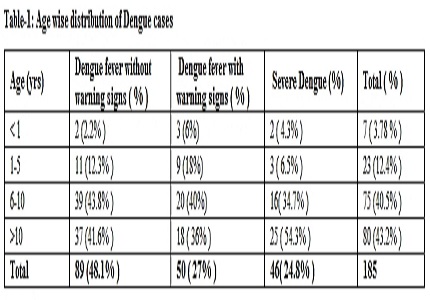Clinical profile and outcome of dengue among hospitalized children - a single centre prospective study
Abstract
Introduction: Dengue is the most rapidly spreading mosquito-borne viral disease in the world.In India, there is increased proportion of Dengue cases with severe disease. Early recognition and prompt initiation of appropriate treatment are vital to reduce disease related morbidity and mortality.
Objective: To study the clinical profile and outcome of hospitalized dengue fever cases in children during outbreaks.
Methods: This is an observational prospective study conducted at tertiary care hospital. All children who presented with clinical features of dengue & dengue serology positive children were included in the study.
Results: A total of 185 children diagnosed to have dengue fever were admitted in the hospital during the study period. The cases were classified according to WHO protocol as Dengue without warning sign (48.1%), Dengue with warning signs (27%) and severe dengue (24.8%). All the children had fever as the presenting complaint. The other predominant symptoms observed were vomiting (61.6%), abdominal pain (50.2%), rashes (30.2%), myalgia (24.3%), and bleeding manifestation (16.2%). The other significant findings noted were Hepatomegaly (52.4%), Ascites (47.01%), and pleural effusion (41%). Gallbladder wall thickness (80.4%) was the most common radiological abnormality. Mortality in this study was 1.08%.
Conclusion: Children in the age group of 5-15 years were most commonly affected. Fever, Persistent vomiting, abdominal pain, Hepatomegaly, pleural effusion, were predominant presenting symptoms and signs. Early recognition, precise assessment and appropriate treatment with the help of WHO revised classification and management guidelines have reduced the mortality.
Downloads
References
2. World Health Organisation. Prevention and control of dengue and dengue haemorrhagic fever: comprehensive guidelines. WHO Regional publication, SEARO, No 29, 1999.
3. Guzmán MG, Kourí G. Dengue: an update. Lancet Infect Dis. 2002 Jan;2(1):33-42. [PubMed]
4. WHO: Dengue Guildelines for Diagnosis, Prevention and Control. New edition. Geneva, Switzerland: World Health Organisation; 2009.
5. Barniol J, Gaczkowski R, Barbato EV, da Cunha RV, Salgado D, Martínez E, Segarra CS, Pleites Sandoval EB, Mishra A, Laksono IS, Lum LC, Martínez JG, Núnez A, Balsameda A, Allende I, Ramírez G, Dimaano E, Thomacheck K, Akbar NA, Ooi EE, Villegas E, Hien TT, Farrar J, Horstick O, Kroeger A, Jaenisch T. Usefulness and applicability of the revised dengue case classification by disease: multi-centre study in 18 countries. BMC Infect Dis. 2011 Apr 21;11:106. doi: 10.1186/1471-2334-11-106.
6. Narvaez F, Gutierrez G, Pérez MA, Elizondo D, Nuñez A, Balmaseda A, Harris E. Evaluation of the traditional and revised WHO classifications of Dengue disease severity. PLoS Negl Trop Dis. 2011 Nov;5(11):e1397. doi: 10.1371/journal.pntd.0001397. Epub 2011 Nov 8. [PubMed]
7. Mittal H, Faridi MM, Arora SK, Patil R. Clinicohematological profile and platelet trends in children with dengue during 2010 epidemic in north India. Indian J Pediatr. 2012 Apr;79(4):467-71. doi: 10.1007/s12098-011-0586-7. Epub 2011 Oct 29.
8. Agarwal R, Kapoor S, Nagar R, Misra A, Tandon R, Mathur A, et al. A clinical study of the patients with dengue hemorrhagic fever during the epidemic of 1996 at Lucknow, India. Southeast Asian J Trop Med Public Health 1999 Dec; 30(4) : 735-40. [PubMed]
9. Narayanan M, Aravind MA, Thilothammal N, Prema R, Sargunam CS, Ramamurty N. Dengue fever epidemic in Chennai--a study of clinical profile and outcome. Indian Pediatr. 2002 Nov;39(11):1027-33. [PubMed]
10. Gomber S, Ramachandran VG, Kumar S, Agarwal KN, Gupta P, Gupta P, Dewan DK. Hematological observations as diagnostic markers in dengue hemorrhagic fever--a reappraisal. Indian Pediatr. 2001 May;38(5):477-81.
11. Wongkoon S, Jaroensutasinee, M, Jaroensutasinee K. Distribution, seasonal variation and dengue transmission prediction in Sisaket, Thailand. Indian J Med Res. 2013 Sep;138(3):347-53.
12. Wang CC, Lee IK, Su MC, Lin HI, Huang YC, Liu SF, et al. Differences in clinical and laboratory characteristics and disease severity between children and adults with dengue virus infection in Taiwan, 2002.Trans R Soc Trop Med Hyg. 2009 Sep;103(9):871-7.
13. Kalayanarooj S, Chansiriwongs V, Nimmannitya S. Dengue patients at the Children’s Hospital, Bangkok: 1995–1999. Review Dengue Bulletin 2002;26:33–43.
14. Ratageri VH, Shepur TA, Wari PK, Chavan SC, Mujahid IB, Yergolkar PN. Clinical profile and outcome of Dengue fever cases. Indian J Pediatr. 2005 Aug;72(8):705-6. [PubMed]
15. Ahmed S, Arif F, Yahya Y, Rehman A, Abbas K, Ashraf S, Akram DS. Dengue fever outbreak in Karachi 2006--a study of profile and outcome of children under 15 years of age. J Pak Med Assoc. 2008 Jan;58(1):4-8.
16. Venkata Sai PM, Dev B, Krishnan R. Role of ultrasound in dengue fever. Br J Radiol. 2005 May;78(929):416-8. [PubMed]
17. Colbert JA, Gordon A, Roxelin R, Silva S, Silva J, Rocha C, Harris E. Ultrasound measurement of gallbladder wall thickening as a diagnostic test and prognostic indicator for severe dengue in pediatric patients. Pediatr Infect Dis J. 2007 Sep;26(9):850-2.
18. Setiawan MW, Samsi TK, Wulur H, Sugianto D, Pool TN. Dengue haemorrhagic fever: ultrasound as an aid to predict the severity of the disease. Pediatr Radiol. 1998 Jan;28(1):1-4. [PubMed]
19. Mehdi S A, Mahais H A, Bhukhari H, Aslam S. Grey scale trans-Abdomino Thoracic Ultrasonography in evaluation of dengue hemorrhagic fever.APMC.2012;6 :32-6.
20. Kumarasamy V, Wahab AH, Chua SK, Hassan Z, Chem YK, Mohamad M, Chua KB. Evaluation of a commercial dengue NS1 antigen-capture ELISA for laboratory diagnosis of acute dengue virus infection. J Virol Methods. 2007 Mar;140(1-2):75-9. Epub 2006 Nov 30.
21. Kabra SK, Jain Y, Pandey RM, Madhulika, Singhal T, Tripathi P, Broor S, Seth P, Seth V. Dengue haemorrhagic fever in children in the 1996 Delhi epidemic. Trans R Soc Trop Med Hyg. 1999 May-Jun;93(3):294-8. [PubMed]
22. Srivastava VK, Suri S, Bhasin A, Srivastava L, Bharadwaj M. An epidemic of Dengue hemorrhagic fever and Dengue shock syndrome in Delhi: a clinical study. Ann Trop Paediatr. 1990 ;10(4): 329-34. [PubMed]

Copyright (c) 2017 Author (s). Published by Siddharth Health Research and Social Welfare Society

This work is licensed under a Creative Commons Attribution 4.0 International License.


 OAI - Open Archives Initiative
OAI - Open Archives Initiative


